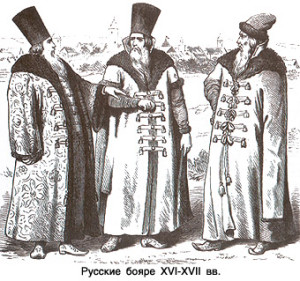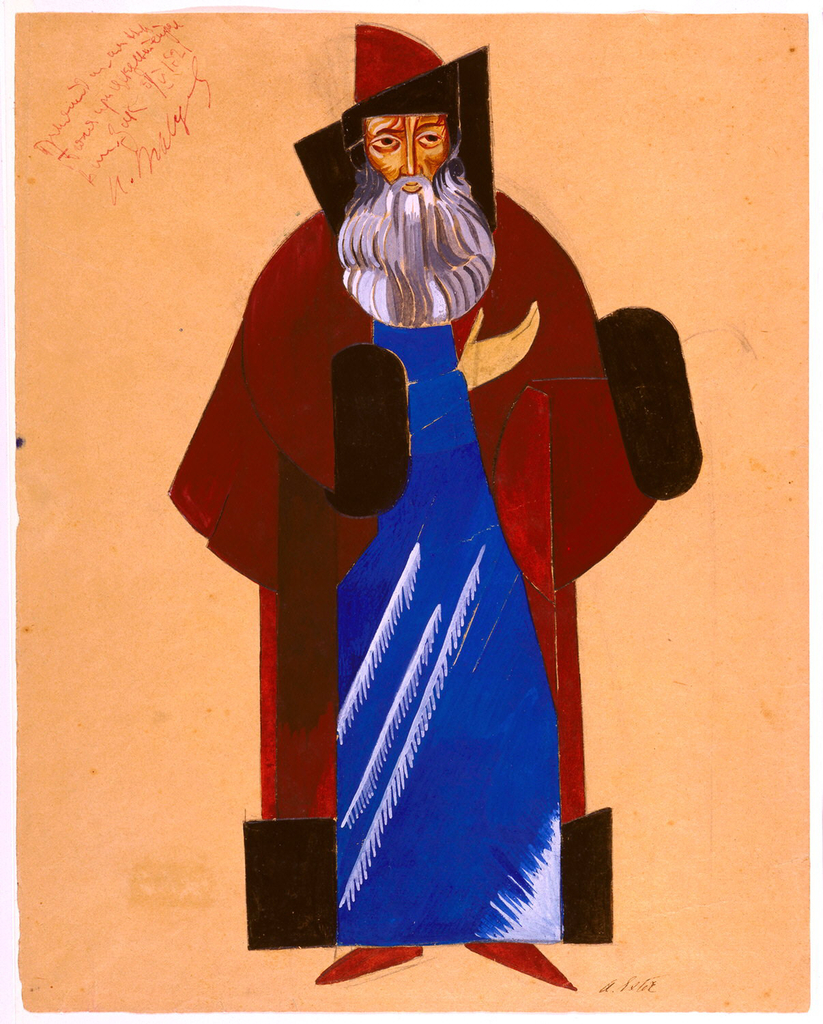This boyar may be old and wizened, but the costume he sports is cutting-edge. His cloak and cap seem to be cut from geometric patterns, in a modern take on medieval fashion. Boyars were high-ranking aristocrats who advised the princes of medieval Russia, but this one wouldn’t look out of place in a cubist or constructivist painting. In step with these artistic movements, designer Alexandra Exter reduces the traditional, ornate uniform of a boyar into elemental shapes and contours. She likely sketched this costume for a theatrical production, and wrote that, to recreate a historical period onstage, one should “capture the fundamental plastic idea of its style, which can by embodied quite freely, without resorting to the copying of museum specimens.”1 Compare Exter’s design to the historical drawing of a boyar (Fig. 1). Note how she refines the traditional cape, streamlining the silhouette while retaining the bulky shoulders and voluminous folds of fabric. Dispensing with tassels and frills, she reinterprets the uniform according to modern principles of design.
After establishing her reputation as a painter, Exter began designing theatre costumes and sets in 1915. In theatre, she saw potential for a total synthesis of different art forms. To this end, she designed costumes, stages, and backdrops to harmonize with a play’s script, as well as its sound and lighting design. She was attracted to dynamism of theater, and her costumes seek to capture an actor’s movement in three dimensions. In this drawing, a structured column of cloth extends from the boyar’s torso to his toes. The architectonic outfit would be conducive to slow, stately movements, befitting of a dignified aristocrat.
Just as Exter simplifies the Boyar’s costume, she abstracts his body to its fundamental form, transforming organic shapes into sharp geometry, like triangular feet and a boxy torso. Exter’s geometric eye is inherited, in part, from cubist innovators Pablo Picasso and Georges Braque, whom she befriended while studying in Paris. Her Boyar sketch adapts the visual language of cubism, infusing it with a Russian sensibility. Exter wrote that “the very environment of Russia demands color.”2 A gifted colorist, she often paired unlikely colors to bold effect, as evident in this burgundy and blue ensemble. She drew inspiration from the vivid, discordant colors traditionally worn by Russian field hands. Here, she imagines a powerful Russian nobleman attired as brightly as a peasant.

Fig. 1: Russian Boyars (unknown artist)
1. Alexandra Exter, “The Artist in the Theater,” Одесский листок, no. 130 (1909): 4, quoted in Amazons of the Avant-Garde, ed. John E. Bowlt and Matthew Drutt (New York: Thames & Hudson, 200), 304.↩
2. Alexandra Exter, “In Search of New Clothing,” Всероссийская выставка, no. 2 (1923): 16-18, quoted in Amazons of the Avant-Garde.↩
Virginia McBride is a Peter Krueger curatorial intern in the Department of Drawings, Prints, and Graphic Design at Cooper Hewitt, Smithsonian Design Museum. She studies art history at Kenyon College.
